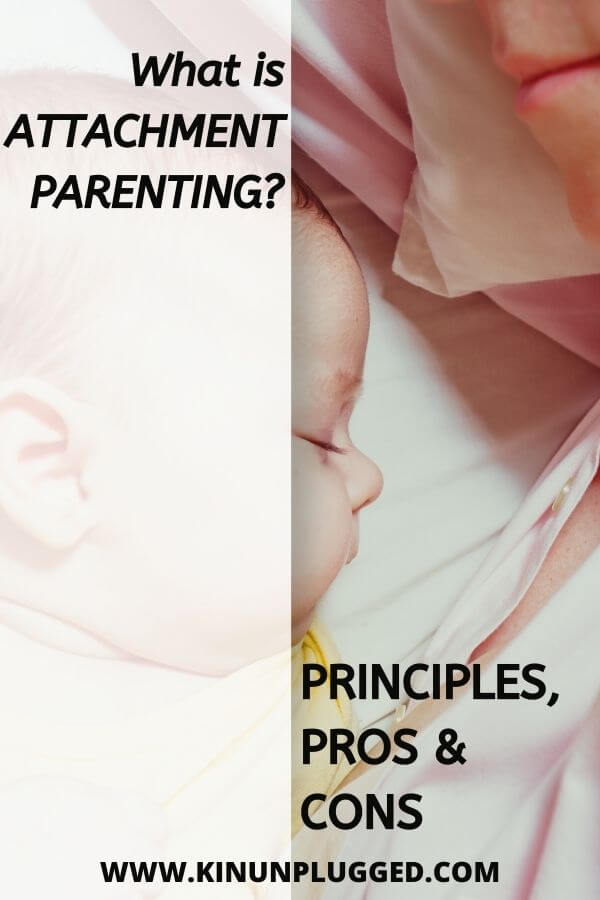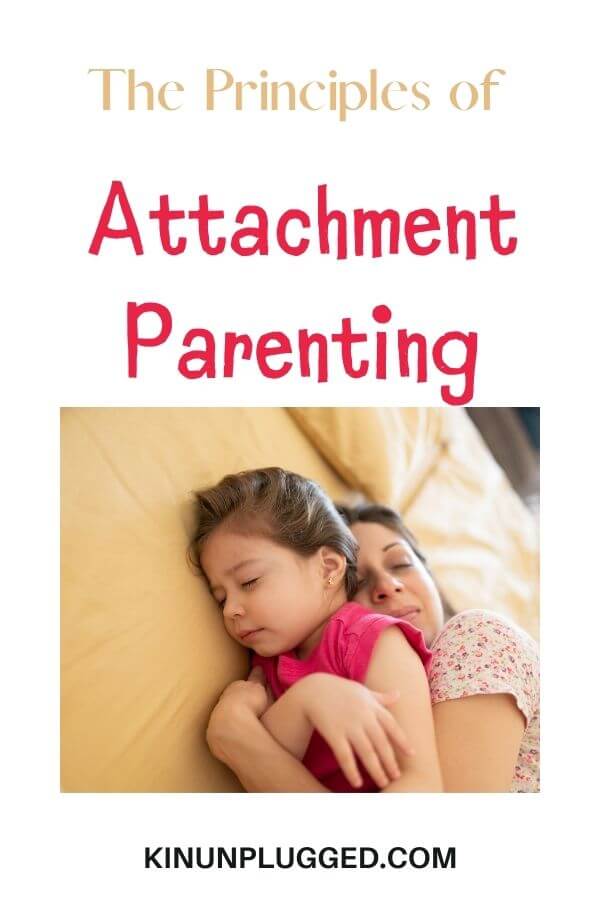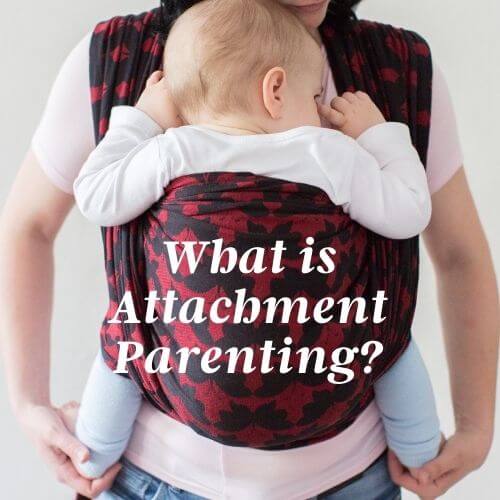If you have always wanted to be a parent, you probably had ideas of what kind of parent you planned to be. You may realize once you actually become a parent that the reality does not match the fantasy. Not every day anyway. Parenting styles can differ not just family to family but also day to day within families. The attachment parenting style is supposed to be stable and secure but even with that, things cannot always go as expected.

I would say I have so far practiced attachment but completely unintentionally. Looking at the principles and values that underpin it, they seem to match my own values when it comes to child care. Without knowing it, you might also be practicing attachment parenting already. Or you might be planning to adopt the principles of attachment parenting once you have children.
So what exactly is attachment parenting?
Explaining the attachment parenting style
Attachment parenting is the focus on creating and maintaining a good connection between parent and child throughout their lives by the parent recognizing and responding to their child’s needs. While it is not necessarily mother-focused by definition alone, it is mainly focused on the mother in practice.
John Bowlby, psychoanalyst, believed that an individual’s behavioral problems stem from their childhood and specifically from long-term deprivation of maternal presence and care.
Sears & Sears (2001) made the concept of attachment parenting popular as a parenting style that was fairly uncommon in the West.
What are the 8 principles of attachment parenting?
The eight principles of attachment parenting centre around the role of the mother as the main person in the child’s life undertaking most of the care. Others would argue for 9 principles instead.
Simpson et al. explain the 8 principles of attachment parenting as follows:
- Attachment theory is both evolutionary and behavioural
- It exists in tandem with other behavioural systems
- The attachment system and caregiving system are interrelated
- Attachment is about seeking proximity, security and safety
- The attachment system is lifelong
- The attachment is supposed to cultivate resilience
- People experience a specific set of feelings and reactions when they are separated from their attachment figures
- While the attachment system is global/universal, it is also changeable depending on culture
You may include a 9th principle that states that the kind of relationship an individual has with their attachment figure shapes their mental representation of themselves.
RELATED: How to have a happy baby – according to science
Attachment Parenting International lists the principles of attachment parenting a little differently:
- Prepare for pregnancy, birth and parenting
- Feed with love and respect
- Respond with sensitivity
- Using nurturing touch
- Ensure safe physical and emotional sleep
- Provide consistent and loving care
- Practice positive discipline
- Strive for balance in personal and family life
What are the 4 types of attachment?
Attachment theory presents 4 different types of attachment:
- Disorganized
This type of attachment was added to this list later on by researchers. It is different from the three other types because it is as it is named – disorganised. The other three are more strategic. It is hard to pinpoint how parents will behave towards their children with this type of attachment.
Parents who show this type of attachment style adopt techniques or styles from all three of the other types of attachment styles. Arguably, the children who develop under this system are just as unpredictable.
- Avoidant
An avoidant attachment style is quite stoic. It is a more uninvolved parenting style. As a parent, you show less emotion and you leave your children to figure tough things out on their own instead of helping them. You do not try to establish a close and emotional relationship with your kids. It is evident how good you are at taking charge in difficult situations and you are a strong and practical shoulder to lean on. However, you are not interested in your children’s feelings.
- Ambivalent
This type of attachment shows a type of parenting where the child can depend on their parent sporadically. As the name suggests, the parent’s care is present sometimes and other times not. The child is unsure of when they can really rely on the parent and this can, as you would imagine, lead to a level of confusion and insecurity.
- Secure
Now, if attachment parenting is the style of parenting that you are aiming for, then secure attachment parenting is the type that you should work to establish. With this type of attachment, you are showing sensitivity to your child’s needs at all times. Of course this means that you are also making yourself available to them so you know when they need you and you make the effort to respond to their needs.

What does attachment parenting look like?
In practice, you could describe attachment parenting as being comprised of the “Seven Bs”:
- Babywearing
- Breastfeeding
- Bedding (sleeping close to baby)
- Balance (both parent and child need to have their needs met)
- Baby’s cry (learning the meaning of your baby’s cries)
- Birth bonding (immediate skin to skin at birth)
- Beware of training (little to no external contribution to how your baby’s schedule is set up by anyone who is not a primary caregiver to baby)
It might look to you like these are difficult to achieve every single day of the parent and child’s life. Indeed, many would argue that considering how stressful modern life is, attachment parenting may not be possible or even desirable. However, you can at least strive for some of the 7 Bs because there are many benefits. I will list only three of them below, followed by only three cons.
RELATED: How to tell if your baby is happy at daycare
Attachment parenting pros and cons
What are the benefits of attachment?
- Reduction in the long term effects of stress on an infant
Research shows that in the long term, individuals are affected by stressful situations experienced from infancy. Effects are both physical and mental. Attachment parenting techniques encourage a parent to be conscious of and attentive to their child’s stress. By addressing a child’s stress quickly by giving them the touch or affection or any other kind of help, you are reducing the chances of them experiencing long-term effects.
- Better brain development
When you are attentive to your children and they are therefore getting their needs met without stress, they are able to focus on learning and development, both in and outside of school. They are able to absorb information better as they are not concerned with struggling to gain their parents attention. Their brains are therefore able to develop at the right rate.
- Emotional stability
You are likely to be raising more emotionally stable children because they are getting their emotional needs met. They are receiving emotional affection and support from you and therefore they are learning from you how to show emotion in different situations. They are also learning how to control their own emotions from you because they see that you have emotional stability.

What are the cons of attachment parenting?
- Disproportionate focus on the mother as the caregiver
This is a con depending on your perspective. While some might argue that it is only natural for individuals’ care to be taken up mainly by their mothers, others would say that it is only fair for fathers to be able to have an equal share of care for their children if that is what they want.
- Can exacerbate symptoms of postpartum anxiety
Another criticism of attachment parenting style is that it puts too much pressure on the mother and that pressure could lead to postpartum anxiety. Particularly for a mom who has previously suffered from anxiety or from postpartum anxiety, the stress of really following the attachment parenting style could cause them to suffer from further bouts of anxiety. Indeed, the argument is that if a mother is experience postpartum anxiety, forcing themselves to practice attachment parenting could make their symptoms worse.
- Diminished focus on other equally important priorities in the parent’s life apart from parenting
The mother (especially new moms) are getting used to a new family set up and getting to know their new child. They are probably finding very little time for themselves and it is therefore very easy for them to get lost in making sure they are following all the principles of attachment parenting, leading them to neglect their own well-being and self-care. Apart from self-care, the amount of attention given to a child if you are strictly focused on attachment principles may mean that you neglect several other aspects of life such as financial management and physical health.








2 Comments
I love how you’ve explained this in depth. It really helps. I’m an “older” mom and my little are grown, but I hear all these things from my daughter!
I’m so glad you found this helpful, Jen.